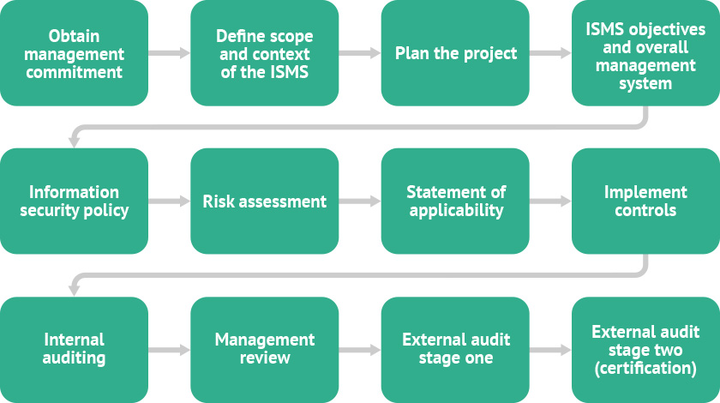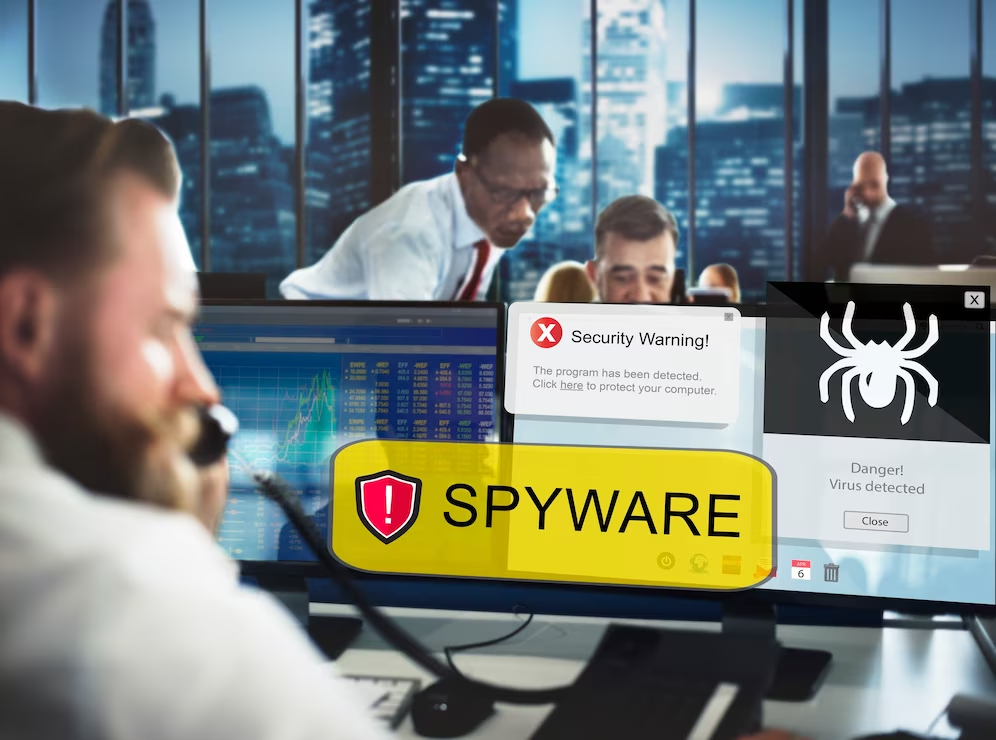Lot 118, Lane 1, 1st Avenue, Gwarimpa Estate, Abuja - Nigeria
Now Hiring: Are you a driven and motivated 1st Line IT Support Engineer?

Lot 118, Lane 1, 1st Avenue, Gwarimpa Estate, Abuja - Nigeria
Now Hiring: Are you a driven and motivated 1st Line IT Support Engineer?

NextBewe
ISO Certification & Compliance
27 february, 2023
Introduction
In today's digital age, ensuring the security of sensitive information has become paramount for organizations. ISO 27001:2013 is an international standard that provides a framework for establishing, implementing, maintaining, and continually improving an information security management system (ISMS). As the IT Manager, acting Chief Information Security Officer (CISO), and lead implementer for my organization, I took on the responsibility of leading the project to achieve ISO 27001:2013 certification. In this article, I will share my experience, expertise, and the steps I took to successfully lead the project.
Table of Contents
1. How I Led the Project to ISO 27001:2013 Certification for My Organization as the IT Manager, Acting CISO, and Lead Implementer
2. Understanding ISO 27001:2013 Certification
- What is ISO 27001:2013?
- Benefits of ISO 27001:2013 Certification
- Importance of Information Security Management
3. Getting Started: Assessing the Current State
- Analyzing Existing Security Measures
- Identifying Gaps and Areas for Improvement
- Establishing the Project Team
4. Developing the Information Security Management System (ISMS)
- Defining Scope and Objectives
- Conducting Risk Assessment and Risk Treatment
- Establishing Policies and Procedures
5. Implementing Security Controls and Measures
- Access Control and User Management
- Network and Systems Security
- Incident Response and Business Continuity
- Staff Awareness and Training Programs
6. Conducting Internal Audits and Reviews
- Internal Audit Planning and Execution
- Management Review Meetings
7. Preparing for External Certification Audit
- Selecting an Accredited Certification Body
- Documenting and Demonstrating Compliance
- Performing Readiness Assessments
8. Successfully Achieving ISO 27001:2013 Certification
- External Certification Audit Process
- Addressing Non-Conformities and Observations
- Celebrating the Achievement
9. FAQs (Frequently Asked Questions)
1. What is the role of the IT Manager in ISO 27001:2013 certification?
2. How long does it take to achieve ISO 27001:2013 certification?
3. Is ISO 27001:2013 certification mandatory for all organizations?
4. What are the key challenges in implementing ISO 27001:2013?
5. How does ISO 27001:2013 certification benefit an organization's reputation?
6. What is the role of senior management in ISO 27001:2013 certification?
10. Conclusion
How I Led the Project to ISO 27001:2013 Certification for My Organization as the IT Manager, Acting CISO, and Lead Implementer
As the IT Manager, acting CISO, and lead implementer, my role was critical in successfully leading the project to ISO 27001:2013 certification. I approached the project with a strategic mindset and a thorough understanding of the standard's requirements.
Here are the key steps I took:
1. Assessing the Current State:
The first step was to assess the organization's current state of information security. I conducted a comprehensive analysis of existing security measures, policies, and procedures. This helped identify gaps and areas that needed improvement to align with ISO 27001:2013 requirements.
2. Developing the ISMS:
Based on the findings from the assessment, I worked closely with the project team to develop the Information Security Management System (ISMS). This involved defining the scope and objectives of the system, conducting a thorough risk assessment, and implementing appropriate risk treatment measures. We established policies and procedures that aligned with ISO 27001:2013 guidelines.
3. Implementing Security Controls:
Implementing the necessary security controls and measures was a crucial aspect of the project. I focused on areas such as access control and user management, network and systems security, incident response, and business continuity. We developed comprehensive staff awareness and training programs to ensure a culture of security within the organization.
4. Conducting Internal Audits:
Regular internal audits were conducted to assess the effectiveness of the implemented controls and processes. This helped identify any non-conformities and provided an opportunity for continuous improvement. I planned and executed internal audits, ensuring compliance with ISO 27001:2013 requirements.
5. Preparing for External Certification Audit:
To achieve ISO 27001:2013 certification, we selected an accredited certification body. We documented and demonstrated compliance with the standard, preparing all the necessary documentation, policies, and evidence. We performed readiness assessments to ensure we were fully prepared for the external certification audit.
6. Successfully Achieving Certification:
The culmination of the project was the external certification audit. We underwent a rigorous assessment by the certification body, addressing any non-conformities or observations that arose during the audit process. With our diligent preparation and commitment to information security, we successfully achieved ISO 27001:2013 certification.
As the lead implementer and IT manager, I was also responsible for designing and implementing the networking infrastructure, which is actually around 70% workload of requirements to get ISO 27001 certified, you can find an article about the general steps I took to accomplish this "HERE"
FAQs (ISO 27001:2013 as a Project)
1. What is the role of the IT Manager in ISO 27001:2013 certification?
- The IT Manager plays a crucial role in leading the project towards ISO 27001:2013 certification. They are responsible for assessing the organization's information security posture, developing and implementing the ISMS, ensuring compliance with the standard's requirements, and coordinating with relevant stakeholders.
2. How long does it take to achieve ISO 27001:2013 certification?
- The timeline for achieving ISO 27001:2013 certification varies depending on the organization's size, complexity, and readiness. It typically takes several months to a year, depending on the resources dedicated to the project and the organization's existing security measures.
3. Is ISO 27001:2013 certification mandatory for all organizations?
- ISO 27001:2013 certification is not mandatory for all organizations. It is a voluntary certification that organizations can pursue to demonstrate their commitment to information security. However, some industries and regulatory frameworks may require ISO 27001:2013 certification as a prerequisite for doing business or ensuring compliance.
4. What are the key challenges in implementing ISO 27001:2013?
- Implementing ISO 27001:2013 can present several challenges. Some common ones include gaining buy-in from senior management, allocating sufficient resources, ensuring employee awareness and participation, addressing complex technical requirements, and maintaining ongoing compliance.
5. How does ISO 27001:2013 certification benefit an organization's reputation?
- ISO 27001:2013 certification enhances an organization's reputation by demonstrating its commitment to information security. It provides assurance to customers, partners, and stakeholders that the organization has implemented robust security controls and follows best practices for protecting sensitive information.
6. What is the role of senior management in ISO 27001:2013 certification?
- Senior management plays a critical role in ISO 27001:2013 certification. They provide leadership, support, and resources to ensure the successful implementation of the ISMS. Their commitment to information security sets the tone for the organization and fosters a culture of security.
Conclusion
Leading the project to ISO 27001:2013 certification for my organization as the IT Manager, acting CISO, and lead implementer was a challenging yet rewarding experience. By following the outlined steps and leveraging my expertise in information security, I successfully guided the organization towards achieving this internationally recognized certification. ISO 27001:2013 certification not only strengthens the organization's information security posture but also instills trust and confidence among stakeholders. It serves as a testament to the organization's commitment to protecting sensitive information and maintaining the highest standards of security.
To embark on the journey towards ISO 27001:2013 certification, it is crucial to conduct a thorough assessment, develop a robust ISMS, implement necessary security controls, and prepare for external audits. With the right approach, dedication, and involvement from all stakeholders, any organization can achieve ISO 27001:2013 certification and reap the numerous benefits it brings.
FAQs (ISO 27001:2013 certification in general)
1. Can ISO 27001:2013 certification be obtained by organizations of any size?
- Yes, ISO 27001:2013 certification is applicable to organizations of all sizes and types. The standard can be tailored to meet the specific needs and requirements of the organization, regardless of its scale.
2. How often is ISO 27001:2013 certification renewed?
- ISO 27001:2013 certification is valid for a period of three years. To maintain the certification, organizations must undergo regular surveillance audits conducted by the certification body.
3. Is ISO 27001:2013 certification recognized globally?
- Yes, ISO 27001:2013 certification is internationally recognized. It provides a framework for establishing and maintaining an effective ISMS that aligns with global best practices for information security.
4. Does ISO 27001:2013 certification guarantee protection against all security threats?
- While ISO 27001:2013 certification helps organizations establish a robust information security management system, it does not guarantee protection against all security threats. It serves as a proactive approach to mitigate risks and ensure continuous improvement in information security practices.
5. Are there specific industries that require ISO 27001:2013 certification?
- While ISO 27001:2013 certification is not industry-specific, it is particularly relevant for organizations that handle sensitive information, such as healthcare, finance, and government sectors. Regulatory frameworks in some industries may also mandate ISO 27001:2013 certification for compliance purposes.
Why your business should get ISO certified?
Enhanced Information Security:
One of the primary advantages of ISO 27001:2013 certification is the establishment of a robust information security management system (ISMS). This framework helps organizations identify, assess, and manage information security risks effectively. By implementing the necessary security controls and measures, organizations can significantly enhance their information security posture, protect sensitive data, and prevent security breaches.
Increased Customer Trust:
ISO 27001:2013 certification is internationally recognized and demonstrates an organization's commitment to information security best practices. Achieving certification can instill confidence in customers, partners, and stakeholders, showcasing that the organization has implemented appropriate security measures to safeguard their sensitive information. This increased trust can lead to stronger business relationships, improved customer satisfaction, and a competitive advantage in the market.
Compliance with Legal and Regulatory Requirements:
Many industries have specific legal and regulatory requirements regarding information security. ISO 27001:2013 certification helps organizations meet these requirements by providing a framework aligned with international standards and best practices. By achieving certification, organizations can ensure compliance with data protection regulations, contractual obligations, and industry-specific requirements, avoiding potential legal and financial consequences.


